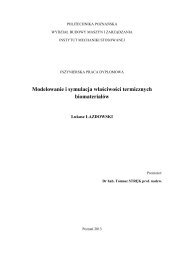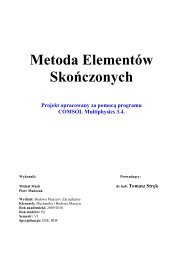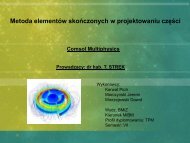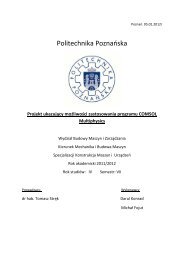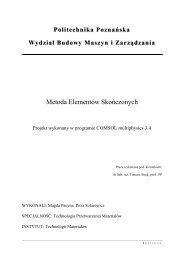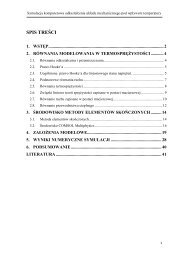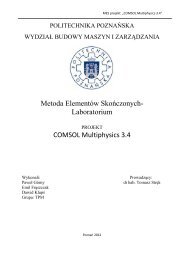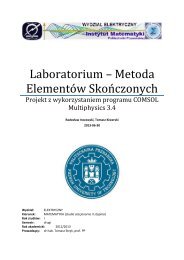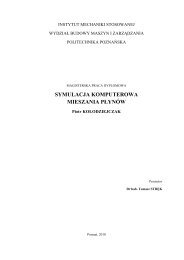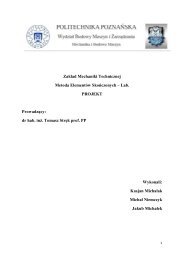COMSOL News
COMSOL News
COMSOL News
Create successful ePaper yourself
Turn your PDF publications into a flip-book with our unique Google optimized e-Paper software.
CHEMICAL<br />
VERYST ENGINEERING LLC, NEEDHAM, MA<br />
NORDSON EFD, EAST PROVIDENCE, RI<br />
“We find that there is excellent overall<br />
agreement between experimental<br />
and simulation results...”<br />
Figure 5. Comparison between experimental data and numerical mixing predictions<br />
at three sections along the first half of the mixer.<br />
for the streamlines and particle tracing.<br />
At this stage, we recognized that the<br />
number of streamlines required to resolve<br />
the very thin streaks in the mixer<br />
was very large. We also found that using<br />
particle tracing in the Particle Tracing<br />
Module required significantly less<br />
computational time.<br />
The streamline and particle tracing<br />
data is exported from <strong>COMSOL</strong> and<br />
used in a newly developed proprietary<br />
algorithm that computes two measures<br />
of mixing quality. The first is a coefficient<br />
of variation (CoV), which is a quantity<br />
that has a value of one for no mixing,<br />
and zero for perfect mixing. Here, “perfect<br />
mixing” is relative to a user-controlled<br />
length scale. The second metric is<br />
a series of cross-sectional mixer images<br />
similar to the Poincaré sections (Figure<br />
4). These images help identify local<br />
streaks of one material that may not be<br />
clearly shown in an overall CoV analysis.<br />
The mixing images can also be stacked<br />
together to create an animation that facilitates<br />
mixing visualization.<br />
Reliable Simulation Results<br />
To validate this modeling tool, we compared<br />
the results to targeted mixing experiments<br />
performed by Nordson EFD<br />
involving the mixing of two epoxy materials<br />
— a black and a white compound.<br />
These materials solidify when mixed.<br />
After solidification, the mixer was sliced<br />
into about forty sections to visually assess<br />
the mixing quality.<br />
Veryst also used<br />
streamline and<br />
particle tracing<br />
data to generate<br />
cross-sectional<br />
images comparable<br />
to the experimental<br />
results.<br />
The mixer crosssection<br />
is divided<br />
into equal sized<br />
cells that can take<br />
four states, depending on the streamlines,<br />
or particles, that intersect that cell.<br />
These values are: (i) material 1, marked<br />
as black; (ii) material 2, marked as white;<br />
(iii) well-mixed, marked as gray; and (iv)<br />
no data. Cells receive no data when they<br />
are in dead-flow zones, or recirculation<br />
zones. To reduce the amount of no-data<br />
zones, we generate particle tracing paths<br />
starting at different sections in the mixer<br />
(not just at the beginning).<br />
Figure 5 shows a comparison between<br />
the experimental data and the numerical<br />
predictions for another Nordson EFD<br />
mixer at three different cross-sections<br />
along the first half of the mixer. The blue<br />
colored regions in the experimental data<br />
About the Companies<br />
are the mixing elements. The black and<br />
white epoxies had slightly different entry<br />
angles in the experiment and in the simulation,<br />
due to the imperfect segregation<br />
of the two epoxies prior to reaching the<br />
mixing elements. This affects the distribution<br />
of black/white epoxy at different<br />
sections along the mixer. However, fluid<br />
entry angles are known to have an insignificant<br />
effect on mixing quality. We find<br />
that there is excellent overall agreement<br />
between experimental and simulation<br />
results in terms of identifying unmixed<br />
regions and fluid streaks.<br />
Optimized Mixer Designs<br />
The CFD simulation, particle tracing,<br />
and data processing algorithm provide a<br />
valuable tool for understanding the flow<br />
patterns inside the mixer beyond what is<br />
possible by pure experimentation. This<br />
is helping Nordson EFD optimize some<br />
of their mixer designs. Veryst Engineering<br />
and Nordson EFD are still working<br />
together on further improving the developed<br />
mixing tools, and expanding their<br />
application to other mixer geometries,<br />
mixing of significantly different fluids,<br />
and non-Newtonian fluid mixing. n<br />
Veryst Engineering, LLC<br />
Veryst Engineering, LLC provides premium engineering services and consulting at the interface<br />
of technology and manufacturing. The Veryst Mission is “Engineering Through the<br />
Fundamentals” employing grounded knowledge of mechanics, physics, manufacturing,<br />
and computational methods to produce practical, useful results. Our consultants’ backgrounds<br />
encompass teaching, extensive publications, industrial experience, and research.<br />
Veryst Engineering is a <strong>COMSOL</strong> Certified Consultant.<br />
Nordson EFD<br />
Nordson EFD is a leading manufacturer of precision dispensing systems that apply accurate,<br />
consistent amounts of the adhesives, sealants, lubricants and other assembly fluids used in<br />
virtually every manufacturing process. In addition to static mixers, Nordson EFD’s 2K Product<br />
Line includes packaging systems and metering-mixing valves for reactive two-component adhesives<br />
and sealants, such as epoxies, urethanes, silicones and acrylics. Nordson EFD products<br />
are available through a worldwide network operating in more than 30 countries.<br />
<strong>COMSOL</strong> NEWS 2 0 1 2 // 6 5<br />
<strong>COMSOL</strong> <strong>News</strong> 2012-17.indd 65<br />
➮<br />
Cov ToC + – A<br />
➭<br />
5/15/12 3:00 PM



